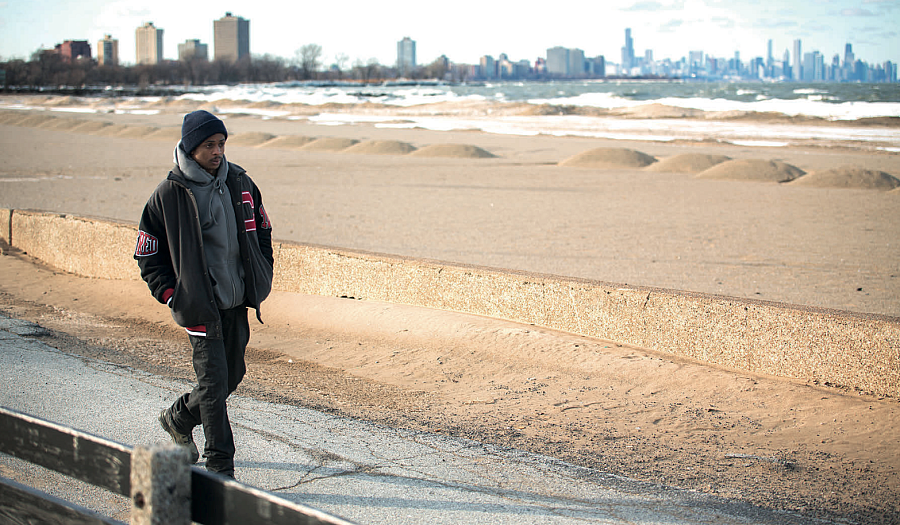Filmmakers tell the human stories behind youth homelessness stats

Anthony, one of three teens followed in "The Homestretch."
“In the end, all you have is yourself to depend on,” a homeless Chicago teen named Anthony tells the filmmakers tracking his life, an existential insight that belies his age.
It’s a sentiment widely echoed by the motley group of kids who bounce around between couches, shelters and the streets in “The Homestretch,” a documentary premiering on PBS on Monday, April 13. The film follows the lives of three teens struggling to regain their footing, find jobs and stay in school after their home lives have fallen apart. In doing so, the film also tells a larger story of a youth homelessness crisis that has left shelters, outreach workers and housing programs struggling to keep pace with demand.
We meet Kasey, a charismatic young woman who dropped out of high school after facing rejection at home. “It’s because of the way I am that my mother got rid of me,” she says in the film, “because, you know, I’m a lesbian.” We’re also introduced to affable Anthony, a teen father who has been homeless since the age of 14. A veteran of the foster system, he ran away from the home of an abusive stepfather who used to beat him with his keys. Then there’s Roque, a gentle presence who is taken in by a big-hearted former teacher after an immigration raid destabilizes his former home with his father. “I have to be my own parents,” he tells the filmmakers. “I don’t need anybody to tell me to be taking things seriously.”
They are just three moving stories in a larger sea of homelessness. The demand for the city’s youth shelter beds routinely outstrips supply, especially when cold nights make living on the street dangerous. Staff at a Chicago youth shelter called The Crib hold a nightly lottery to determine who gets a safe haven.
Pat Scott, a homeless liaison at one of the city’s public high schools, hands out bus cards and connects homeless students with whatever services she can, but the number of homeless students keeps growing, she says, fighting back tears. “My list has grown considerably this year — it just feels a little overwhelming,” she says. More than 19,000 students were registered as homeless in the Chicago Public School system, we’re told.
But perhaps no one in the film captures the challenge of addressing the underlying problems better than Jake Bradley, a youth outreach worker:
I’ve been trying really hard for a long time to eradicate youth homelessness. And it’s not working. But sometimes it works for a few minutes for a few young people. It’s the right thing to do to be with someone and welcome them and support them, even if that’s all you can do in that moment. It’s really hard to explain that to people who are so obsessed with outcome measures and expect that we’re going to give a young person a sandwich and then immediately they’re going to live independently in their own apartment and get a job and complete college and enroll in therapy and never smoke pot again. For the most part, those things don’t stem immediately from the delivery of a sandwich to a person.
You don’t have to strain to hear the frustration in Bradley’s voice over the disconnect between talk of “measurable outcomes” and the kinds of small but essential human gestures that outreach workers provide to homeless kids on a daily basis. A sandwich and a warm shoulder may not be enough — and certainly won’t stand out in annual report — but for Bradley and some of the kids he serves, sometimes it’s all they have to offer.
Other teens are more fortunate in finding help. Anthony is able to enter the “Year Up” professional training program, where he pursues an interest in telecommunications. He eventually receives fully subsidized housing, and dreams of having a being a positive role model for his young son, in foster care. Kasey endures a series of personal crises and setbacks, but she, too, eventually receives subsidized housing. Roque, warmly taken in by the family of his former teacher, reads “Hamlet” and works to overcome his low high school GPA and undocumented status to fulfill his goal of attending college.
But the film is more committed to an honest portrayal of its subjects’ lives, rather than any kind of simple redemption narrative. We also learn what happens when its subjects are kicked out of transitional housing programs for curfew violations, or when mental health crises seem to erode hard-won progress, or when sorely needed jobs and college admissions fail to materialize. Being a teen is hard for anyone; finding success as a homeless teen takes a special kind of grit.
“In our film the three young people that we follow were all homeless for very different reasons,” director and producer Anne de Mare said at the Cleveland International Film Festival a few weeks ago. “But we wanted to show, once you’re in that situation, how can you move out of it? That was really the goal of the film — it wasn’t to go in and capture this horrible situation, but to follow young people through the ups and the downs to show really what it takes to move forward. Because I think that’s really what people don’t understand.”
It’s a film that doesn’t pretend to have all the answers, but surely it helps us understand.
[Image above from The Homestretch.]
